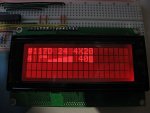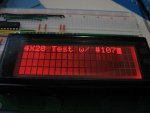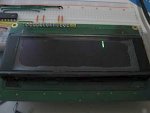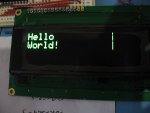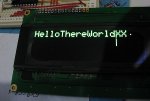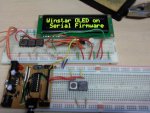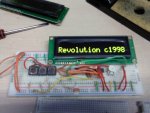OLED Displays from Winstar
- Thread starter MearCat
- Start date
My first test with the OLED failed  . Contrary to technicals success with the AXE033 and a 16x2 Winstar OLED, nothing was displayed on my 4x20 Winstar OLED.
. Contrary to technicals success with the AXE033 and a 16x2 Winstar OLED, nothing was displayed on my 4x20 Winstar OLED.
The program consisted of nothing but (on an 08M) :
SEROUT 4, T2400, ("?f4X20 Test w/ #107")
END
The 08M, #107 serial IC and a HD44780 4x20 LED was wired up in a breadboad and got the proper boot screen and the text...
The program consisted of nothing but (on an 08M) :
SEROUT 4, T2400, ("?f4X20 Test w/ #107")
END
The 08M, #107 serial IC and a HD44780 4x20 LED was wired up in a breadboad and got the proper boot screen and the text...
Attachments
-
28.1 KB Views: 72
-
24.3 KB Views: 55
Try putting a HIGH 4 : PAUSE 500 before the SEROUT as you are using Txxxx polarity.The program consisted of nothing but (on an 08M) :
SEROUT 4, T2400, ("?f4X20 Test w/ #107")
END
hippy - I added the HIGH and PAUSE commands. The program is now
So after the good test (pics above) that ensured the #107 was wired up correctly, I removed the resistors etc for the contrast to Pin 3 and backlighting to Pins 15 & 16 (contrast & backlighting are not relevant for the OLED), then plugged in the Winstar OLED and powered up the circuit with the code as above and got nothing but a single broken line. I didn't get a boot screen, but the "?f.." seemed to clear the screen, but no text appeared. I then changed the ?f to other commands like ?c and ?s and the screen cleared when those commands ran too (I use a SERTXD command immediately before the ? commands to see when they ran).
It's too cold at the moment to play with my car in the garage, so I will have some more time to play with this OLED in the coming days. I was hoping it was something simple like getting it in the correct (Character) mode, but re-reading the datasheet shows that it automatically initialises into Character mode when powered on. It did cross my mind to whether I have a faulty OLED unit, but there I really woudn't know how to confirm.
Code:
SYMBOL LCD = 4 ' Pin 3 (Output 4) for output to Serial IC
HIGH 4
PAUSE 500
SEROUT LCD, T2400, ("?f4X20 Test w/ #107")
ENDIt's too cold at the moment to play with my car in the garage, so I will have some more time to play with this OLED in the coming days. I was hoping it was something simple like getting it in the correct (Character) mode, but re-reading the datasheet shows that it automatically initialises into Character mode when powered on. It did cross my mind to whether I have a faulty OLED unit, but there I really woudn't know how to confirm.
Attachments
-
16.4 KB Views: 67
Last edited:
Using Hippys great LCD interfacing web page, I wired up a circuit on a second breadboard and used Hippys sample code ... I could write "Hello World!" to both the 20x4 LED AND the Winstar OLED. So the OLED does work which is a relief, however I still get those odd pixels on the RHS of the display as soon as I send the command to turn the internal power for the display on (see pic below).
So even though breadboard No.1 was writing okay to the LED but not the OLED, I swapped the #107 with a new one and the OLED now gets a boot screen, but when I send the "?f" or "?!01" (direct control of the OLED) the command to the #107, the OLED did not clear and no text can be sent either However the ?l command does clear the boot screen line.
However the ?l command does clear the boot screen line.
I will continue playing with Breaboard No. 2 and using Hippys code to write direct instructions, but I'd really like to see if the #107 will work with the OLED as it's certainly a more convinient option that controlling it directly.
So even though breadboard No.1 was writing okay to the LED but not the OLED, I swapped the #107 with a new one and the OLED now gets a boot screen, but when I send the "?f" or "?!01" (direct control of the OLED) the command to the #107, the OLED did not clear and no text can be sent either
I will continue playing with Breaboard No. 2 and using Hippys code to write direct instructions, but I'd really like to see if the #107 will work with the OLED as it's certainly a more convinient option that controlling it directly.
Attachments
-
36.6 KB Views: 57
In one of your earlier posts, the odd pixels only occupied the top line and not two lines. They also look like characters that can occupy the CGRAM on startup. Do they go away if you write text over them and if not, does more appear if you go onto the next line?however I still get those odd pixels on the RHS of the display as soon as I send the command to turn the internal power for the display on (see pic below).
I don't know how things are with the Winstar OLED displays, but with the OLED displays that I have tried, There are a few things that work different than with a LCD display.
A command takes up to 12 times as long to execute on an OLED display than on a LCD display.
A clear display command (0x01) clears the display but does not reset the DDRAM address to 00H on the OLED. It resets the DDRAM address to 00H on the LCD.
The OLED has 4 different fonts built in, While testing things, I would frequently find that non-English letters would be displayed on the OLED display
I have been having better success driving an OLED directly from a PicAxe using 4 bit parallel mode.
Joel
A command takes up to 12 times as long to execute on an OLED display than on a LCD display.
A clear display command (0x01) clears the display but does not reset the DDRAM address to 00H on the OLED. It resets the DDRAM address to 00H on the LCD.
The OLED has 4 different fonts built in, While testing things, I would frequently find that non-English letters would be displayed on the OLED display
I have been having better success driving an OLED directly from a PicAxe using 4 bit parallel mode.
Joel
Fortunately it does with this one. The description in the Winstar datasheet says that Clear Display instruction "Clears entire display. Sets DDRAM Address 0 into the Address Counter"...A clear display command (0x01) clears the display but does not reset the DDRAM address to 00H on the OLED.
...
So some more testing with the #117 reveals :
- ?f with a pause after does nothing. Still no text appears.
- None of the #117 commands do anything they're supposed to - ?f, ?b, ?c3, even tried a few variations of ?! to pass command directly to the display to turn display on/off, cursor on/off, clear screen. All these commands do work as expected if Breadboard No.2 when "Hippys code" is used.
- I've only just realised that the #117's boot screen on the OLED only shows the first line "#117 24 4x20" and not the second one (which normally shows the custom characters etc). This is the most intruiging part of the testing so far - I have to confirm what the memory location for the first character at Line 2 is - compared to the HD44780 display
If I write text, it goes straight over the top of those pixels that are lit and those pixels occur only on the first two lines. Those odd pixels still concern me.In one of your earlier posts, the odd pixels only occupied the top line and not two lines. They also look like characters that can occupy the CGRAM on startup. Do they go away if you write text over them and if not, does more appear if you go onto the next line?
UPDATE: Overnight I received an email from Winstar directly and they have confirmed the unit is faulty. Specifically they said "I am afraid this module is break"
Attachments
-
43.4 KB Views: 66
Last edited:
Well, from the experiences here, the massive increase in price compared to an lcd doesn't seem worthwhile and this is putting me off shelling out for a large 16x2 one from Rapid for £24 but as power consumption is only better than a matrix-backlit LCD, OLED doesn't seem the way of the future. Plus, is there actually any way to dim them? The contrast ratio improvement probably won't be significant either but as i have never seen one in person and a lot of people in this forum have, I would like to know if it actually does look better.
Well if they don't want the faulty one back then you can consider it as a free 15x4 OLED module by covering up the damaged portion with black card or tape!UPDATE: Overnight I received an email from Winstar directly and they have confirmed the unit is faulty. Specifically they said "I am afraid this module is break"I will now wait (hopefully not another 2 1/2 months!) for a new display and begin testing from the beginning.
£24 does seem excessive for a 16x2, we will soon have them in stock for much less than that.Well, from the experiences here, the massive increase in price compared to an lcd doesn't seem worthwhile and this is putting me off shelling out for a large 16x2 one from Rapid for £24 but as power consumption is only better than a matrix-backlit LCD, OLED doesn't seem the way of the future. Plus, is there actually any way to dim them? The contrast ratio improvement probably won't be significant either but as i have never seen one in person and a lot of people in this forum have, I would like to know if it actually does look better.
OLEDs doen't have contrast, they are either on and off. And the contrast difference is absolutely stunning in real life, both in contrast and particularly with 'angled viewing'. Once you have seen one in real life you will not want to use an LCD if you can afford an OLED! OLEDs are more pricey at present, but will definately drop in price over the next couple of years.
The normal size OLEDs were just under £17 - this price were for the large one which is the same size as these LCDs here. As the OLEDs seemed to have slightly smaller characters than their LCD counterparts anyway, I thought that it wouldn't be worthwhile getting a small one, plus all the small ones have the connectors on either the top or side so wouldn't fit straight onto a breadboard that takes an LCD with the connector at the bottom as there will be a thick load of wires stuffed underneath it.£24 does seem excessive for a 16x2, we will soon have them in stock for much less than that.
OLEDs doen't have contrast, they are either on and off. And the contrast difference is absolutely stunning in real life, both in contrast and particularly with 'angled viewing'. Once you have seen one in real life you will not want to use an LCD if you can afford an OLED! OLEDs are more pricey at present, but will definately drop in price over the next couple of years.
OLED Displays here.
Also I hear that they die quickly under fluorescent lighting but would leaving one on my worktop about 1.5m away from a 36w fluorescent light kill it fast or have almost no effect at all?
Plus are the OLEDs actually dimmable or are they fixed at one brightness?
ADDED: Am I right in thinking that the green variants are that horrible vomitey-green colour that VFDs commonly are or are they a decent green?
Last edited:
SparkyDave
Member
OLED Displays
For those in Australia that are interested in OLED's, I have found these:
http://au.mouser.com/search/refine.aspx?Ntk=P_MarCom&Ntt=135993233&utm_source=supplier&utm_medium=featured+spotlight&utm_campaign=135993233
I have only just started looking at the datasheets but used with the FRM010 serial chip, could be pretty good.
For those in Australia that are interested in OLED's, I have found these:
http://au.mouser.com/search/refine.aspx?Ntk=P_MarCom&Ntt=135993233&utm_source=supplier&utm_medium=featured+spotlight&utm_campaign=135993233
I have only just started looking at the datasheets but used with the FRM010 serial chip, could be pretty good.
I decided to get the OLED display. After receiving it, I noticed that, although the datasheet says that pin 3 has no connection, it has got a track coming from it. What is the function of this?
ADDED: I think it might be because the designers get paid for the number of tracks they put on the PCB as the unused pins 15 and 16 which would be for a backlight on an LCD are also connected to some random place in the circuitry.
ADDED: I think it might be because the designers get paid for the number of tracks they put on the PCB as the unused pins 15 and 16 which would be for a backlight on an LCD are also connected to some random place in the circuitry.
Last edited:
Pin 3 is the contrast connection for LCDs and the OLED does not have a contrast (or backlight on pins 15 & 16)I decided to get the OLED display. After receiving it, I noticed that, although the datasheet says that pin 3 has no connection, it has got a track coming from it. What is the function of this?
The pin layout seems to be a standard (although I don't know whether it's an official one). They probably maintain the same pinout so that it can be easily interchanged/upgraded from LED to OLED.
I've sent my faulty OLED back to Winstar for a replacement (3-4wk turnaround
To use graphics mode of the OLED I was using an 18A and sending commands directly to the display (not a serial backpack IC)
Write $1F command to OLED to change to graphics mode
Write $80 and $40 to OLED to reset CGRAM & DDRAM address
Write $FF to display a horizontal line of 8 pixels.
I have got the OLED display to work with the Serial Firmware Chip. Received serial commands work fine but Rev-Ed's welcome message doesn't.
In the meantime, here's some pictures of it working with Rev-Ed's serial firmware chip (except the welcome screen which doesn't work). They are attached. Interestingly, in the pictures it looks quite greenish but in real life it's yellow.
ADDED THINGS: I've noticed that the OLED takes around half a second to warm up after it is turned on. Also, since I bought some new PICAXE-40X2s and PICAXE-28X2s, I decided to see if it is true that it prints to the terminal "HELLO I AM YOUR PICAXE-40X2" and it does!
The OLED's PCB lacks the spaces for a resistor ladder and has other things like an inductor mounted on it so it would be impossible for it to be re-used in LCDs. I also purchased a normal large character 16x2 LCD and that does have a different PCB.MearCat said:The pin layout seems to be a standard (although I don't know whether it's an official one). They probably maintain the same pinout so that it can be easily interchanged/upgraded from LED to OLED.
There's a GRAPHICS MODE!!!? Looking at my 16x2 OLED, there is an extra row of pixels between each row of text so that's probably for the graphics mode - so on mine it's 100 x 17 pixels. Ok, I'll work on getting the graphics mode to work. For the serial display, commands can be sent using 254,command but I do have a stripboard assembly for a 40X2 and a parallel LCD that I can use if the serial one doesn't work.To use graphics mode of the OLED I was using an 18A and sending commands directly to the display (not a serial backpack IC)
Write $1F command to OLED to change to graphics mode
Write $80 and $40 to OLED to reset CGRAM & DDRAM address
Write $FF to display a horizontal line of 8 pixels.
In the meantime, here's some pictures of it working with Rev-Ed's serial firmware chip (except the welcome screen which doesn't work). They are attached. Interestingly, in the pictures it looks quite greenish but in real life it's yellow.
ADDED THINGS: I've noticed that the OLED takes around half a second to warm up after it is turned on. Also, since I bought some new PICAXE-40X2s and PICAXE-28X2s, I decided to see if it is true that it prints to the terminal "HELLO I AM YOUR PICAXE-40X2" and it does!
Attachments
-
585.5 KB Views: 51
-
549.8 KB Views: 46
Last edited:
Have you got a link to the datasheet ?Any ideas why?
http://www.rapidonline.com/netalogue/specs/57-2296.pdfHave you got a link to the datasheet ?
I think this is an issue of the datasheet describing the controller capabilities which are different to what the 'glass' of the display supports. Graphics mode allows 16 x 100 pixels to be addressed, but from the earlier diagram there's only 16 COM and 80 SEG lines taken to the 'glass'.I've experimented with the graphics mode with direct connection to the PICAXE and it groups everything into the 16x2 grid so every five columns a column is automatically skipped. Any ideas why?
The 'glass' is 2 lines of 16 characters, each 8 by 5 pixels in size = 1280, but 2 x 20 x 8 x 5 = 1600, so I would guess the controller is designed for 16 or 20 character wide displays and only puts graphics in the 8 x 5 areas of each character. So the lines are 16 ( or 20 ) areas 5 pixels wide rather than a continuous strip of pixels.
It's a character display with 'graphic control', rather than a graphical display.
So the graphic display mode is rather useless and is just like an inconvenient-to-use feature which basically provides an infinite amount of CGRAM characters providing you can provide the normal characters as well... so a waste of time. Looking at the OLED panel though there are segments in between where the characters are so they could just be re-using a panel from a graphic OLED.It's a character display with 'graphic control', rather than a graphical display.
I think you're right; it gives an infinite amount of CGRAM characters. At least that was the conclusion I came to.
Whether waste of time or useless really depends on whether you can live with eight CGRAM characters or desire more. I'd rank it as one of those things which is there if you need it, ignore it if you don't.
Whether waste of time or useless really depends on whether you can live with eight CGRAM characters or desire more. I'd rank it as one of those things which is there if you need it, ignore it if you don't.
Nick12ab - When I first read the datasheet before buying the OLED display, I got excited about this combined graphics and character control and after some testing I ended up with exactly the same result as you - a segment (column of pixels) is automatically skipped every 5 columns because there are only 100 segments available in each line (100 in a 20x4 display, 80 in a 16x2 display).
The only benefit I can see of having such a character display with 'graphic control' is the ability to store a large number of custom 5x8 characters (eg custom font table) in say, EEPROM, and display them at will.
I was hoping to do some custom graph type symbols and large custom characters but it seems not possible with this this character based display I do hope that Phandersons #117 "big number" mode will work with the OLED though.
I do hope that Phandersons #117 "big number" mode will work with the OLED though.
The only benefit I can see of having such a character display with 'graphic control' is the ability to store a large number of custom 5x8 characters (eg custom font table) in say, EEPROM, and display them at will.
I was hoping to do some custom graph type symbols and large custom characters but it seems not possible with this this character based display
Last edited:
We think you are mainly confusing graphics OLEDs with alphanumeric OLEDS.
Look at Winstar's website here:
http://www.winstar.com.tw/products_detail.php?lang=en&CID=45
For each physical size there are clearly two types e.g. 16x2 or 100x16 are physically identical.
The chip/PCB is the same each time, it's just the 'OLED glass' that gives you either type. So for proper graphics without the 'missing lines' you do need to buy the more expensive '100x16' not the '16x2' type. Graphics on the alphanumeric type will always be restricted to the actual pixels available.
Look at Winstar's website here:
http://www.winstar.com.tw/products_detail.php?lang=en&CID=45
For each physical size there are clearly two types e.g. 16x2 or 100x16 are physically identical.
The chip/PCB is the same each time, it's just the 'OLED glass' that gives you either type. So for proper graphics without the 'missing lines' you do need to buy the more expensive '100x16' not the '16x2' type. Graphics on the alphanumeric type will always be restricted to the actual pixels available.
Last edited:
I disassembled an OLED and identically sized same brand LCD and the OLED has 134 connections in total but the LCD only has 96! The LCD is also 16x2 and is the large one from Rapid's range.
The OLED has extra visible pictures and appears as a matrix of 100 x 17 pixels which appear a purplish colour when off. I took a photo but unfortunately in the picture it just looked like the OLED had a dark blue screen and the camera focused on the background so there's no picture to show it but they seem to re-use the same panel but as it is marketed as a character OLED, they might have changed the PCB so that some rows on the panel were not used.
P.S. in the photos the graphic OLED module has the small holes on the right-hand side closer together.
P.S.S. the 17th row of pixels is probably because Winstar are bad at counting so they stuck the extra row on just in case there weren't enough!
The OLED has extra visible pictures and appears as a matrix of 100 x 17 pixels which appear a purplish colour when off. I took a photo but unfortunately in the picture it just looked like the OLED had a dark blue screen and the camera focused on the background so there's no picture to show it but they seem to re-use the same panel but as it is marketed as a character OLED, they might have changed the PCB so that some rows on the panel were not used.
P.S. in the photos the graphic OLED module has the small holes on the right-hand side closer together.
P.S.S. the 17th row of pixels is probably because Winstar are bad at counting so they stuck the extra row on just in case there weren't enough!
Last edited:
Although the instruction set says that there are only three selectable font tables, all four are actually selectable. If you like your Ss more curlier, your As pointy, and don't want the normally descending letters being a pixel taller than the other lower case letters, then the fourth character set is for you. It if the [FT1:FT0]=11 combination that the datasheet says is N/A. If you want to use it but also swap between OLED and LCD, you could use a jumper to select which you're using and use this initialisation code where displayselector is defined as a pin variable.The OLED has 4 different fonts built in, While testing things, I would frequently find that non-English letters would be displayed on the OLED display
Code:
lcddata = %00000110 : pulsout enable,400
lcddata = %00001100 : pulsout enable,400
if displayselector = 0 then
lcddata = %00111000 : pulsout enable,400
else
lcddata = %00111011 : pulsout enable,400
end if
lcddata = %00000001 : pulsout enable,400ADDED: You can use the jumper to also remove the backlight and contrast options from any setup menu your program has (if those settings are controlled by the PICAXE).
MORE ADDED: A comparison of some of the letters in the two font tables with the default on top and the western european II table at the bottom. (also note zener diode to protect my investment!)
Attachments
-
253.1 KB Views: 68
Last edited:
I've checked pins 15 and 16 with a multimeter and pin 15 is at Vdd and pin 16 is at Vss, the opposite way around from what a backlight would normally be. Therefore, connecting these pins may damage the OLED.Pin 3 is the contrast connection for LCDs and the OLED does not have a contrast (or backlight on pins 15 & 16)
The pin layout seems to be a standard (although I don't know whether it's an official one). They probably maintain the same pinout so that it can be easily interchanged/upgraded from LED to OLED.
I thought I'd post an update of where I am in regards to the Winstar OLED. I had issues with a few pixels permanently staying lit during the OLED operation adn sent it back to Winstar 6 weeks ago to get fixed. I received an email last week advising that the module has been fixed and will be shipped soon but today, I received another email :
"I was supposed to send you a sample this week. However, all OLED products are on hold for shipment due to company policy.
In the past month, customers were confused by the lead time, because we've been working on renewing OLED according to the feedback from customer, it's for better quality and lower yield rate. Now the problem is solved and we change a material in OLED and this policy applys to all OLED orders including completed OLED products in stock, so I'm not able to send you the sample with old material. The new sample is producing, I'll send to you as soon as it's ready. "
Unfortunately, I have no idea on lead time for this new / improved model. To date, it's been 5 months total - of waiting for the initial order to arrive, a week or so of testing in my hands, send in the faulty part back, more waiting to get it repaired and now more waiting for a newer model.
 Good thing it's just for some testing and not a critical part!
Good thing it's just for some testing and not a critical part!
"I was supposed to send you a sample this week. However, all OLED products are on hold for shipment due to company policy.
In the past month, customers were confused by the lead time, because we've been working on renewing OLED according to the feedback from customer, it's for better quality and lower yield rate. Now the problem is solved and we change a material in OLED and this policy applys to all OLED orders including completed OLED products in stock, so I'm not able to send you the sample with old material. The new sample is producing, I'll send to you as soon as it's ready. "
Unfortunately, I have no idea on lead time for this new / improved model. To date, it's been 5 months total - of waiting for the initial order to arrive, a week or so of testing in my hands, send in the faulty part back, more waiting to get it repaired and now more waiting for a newer model.
That's probably why Rev-Ed's new OLEDs are so cheap - they got a load of these on clearance (but I have no proof of this).
The improvements in the new one could be:
The improvements in the new one could be:
- Better readability in daylight - current ones have a horrible purple reflection
- Brightness being no longer affected by how many pixels are lit - but that could be an issue with the OLED's onboard power supply.
This is a totally unacceptable and unfounded comment - we do not ship sub-standard goods and these are received new this week direct from the manufacturer. Please think about what you are saying before posting. We have a good price because we buy in very large volumes.That's probably why Rev-Ed's new OLEDs are so cheap - they got a load of these on clearance (but I have no proof of this).
Tech - do you have any details the improvements that have been made in the new model?...these are received new this week direct from the manufacturer...
Gotta agree with Technical on this one, (though I can't actually recall ever disagreeing with him on anything in any event.) My observation over the last year + that I've used the products and followed the forum is that Rev. Ed. is run the way businesses should be run, honest and reputable, with good products. That's an ever shrinking portion of the business world, but I'm very glad they're fighting the growing Chinese trend of incompetence, miserable or no documentation, zero support, and selling any crap they can spew out of the factory, good, bad or indifferent.
If Rev. ED. is willing to sort through the seas of junk and pull out the good stuff and support it and sell it, I say more power to them. Unlike elsewhere, when I purchase something from Rev. Ed. there's actually a pretty darn good likelihood it will work. If it doesn't, I'm confident they will make it right. Can't do any better than that these days.
If Rev. ED. is willing to sort through the seas of junk and pull out the good stuff and support it and sell it, I say more power to them. Unlike elsewhere, when I purchase something from Rev. Ed. there's actually a pretty darn good likelihood it will work. If it doesn't, I'm confident they will make it right. Can't do any better than that these days.
Two months later... and I've received the replacement 4x20 OLED from Winstar. Everything (ie - circuit design from what I can see on the PCB) seems to be the same and I've tested it against against my multiple test programs and they all work as they did previously. I can still send commands directly to the display (directly from a 18A PICAXE, not a serial backpack IC) but after much testing I have come to the conclusion that it will not work with the Phanderson #117 Serial LCD chip. Even the basic operation of sending text will not work, nor will anything like sending direct commands from the #117 to the OLED (eg. ?!01)
I wonder whether the AXE133 or another kit/IC will work?...
I wonder whether the AXE133 or another kit/IC will work?...
Last edited:
The AXE133 works fine with a 20x4 OLED - you can download the firmware file from the www.picaxe.com/products/axe133y page
Excellent! Thanks Tech. One AXE133 purchase to be made soon...The AXE133 works fine with a 20x4 OLED - you can download the firmware file from the www.picaxe.com/products/axe133y page
It's a pity though. I really liked the "Big Number" mode on the #117.
Last edited:

